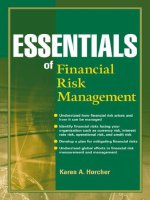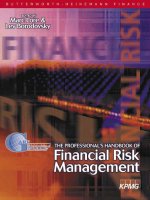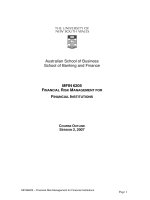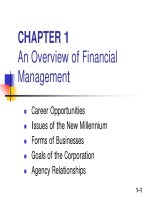Elements of financial risk management chapter 1
Bạn đang xem bản rút gọn của tài liệu. Xem và tải ngay bản đầy đủ của tài liệu tại đây (545.94 KB, 53 trang )
1
Risk Management
and Financial Returns
Elements of Financial Risk Management
Chapter 1
Peter F. Christoffersen
Elements of Financial Risk Management Second Edition © 2012 by Peter Christoffersen
Overview
• Become familiar with the range of risks facing
corporations, and how to measure and manage these
risks
• Become familiar with the salient features of
speculative asset returns
• Apply state-of-the-art risk measurement and risk
management techniques
• Critically appraise commercially available risk
management systems and contribute to the construction
of tailor-made systems
• Understand the current academic and practitioner
literature
Elements of Financial Risk Management Second Edition © 2012 by Peter Christoffersen
2
Objectives
• Become familiar with the range of risks facing
corporations, and how to measure and manage these
risks
• Become familiar with the salient features of
speculative asset returns
• Apply state-of-the-art risk measurement and risk
management techniques
• Critically appraise commercially available risk
management systems and contribute to the
construction of tailor-made systems
• Understand the current academic and practitioner
literature
Elements of Financial Risk Management Second Edition © 2012 by Peter Christoffersen
3
Why should firms manage risk?
• Classic portfolio theory: Investors can eliminate firmspecific risk by diversifying holdings to include many
different assets
• Investors should hold a combination of the risk-free
asset and the market portfolio.
• Firms should not waste resources on risk management,
as investors do not care about firm-specific risk.
• Modigliani-Miller: The value of a firm is independent
of its risk structure.
• Firms should simply maximize expected profits
regardless of the risk entailed.
Elements of Financial Risk Management Second Edition © 2012 by Peter Christoffersen
4
Why should firms manage risk?
• Bankruptcy: The real costs of company
reorganization or shut-down will reduce the current
valuation of the firm. Risk management can increase
the value of a firm by reducing the probability of
default.
• Taxes: Risk management can help reduce taxes by
reducing the volatility of earnings.
Elements of Financial Risk Management Second Edition © 2012 by Peter Christoffersen
5
Why should firms manage risk?
• Capital structure and the cost of capital: a major
source of corporate default is the inability to service
debt. Proper risk management may allow the firm to
expand more aggressively through debt financing.
• Employee Compensation: due to their implicit
investment in firm-specific human capital, key
employees often have a large and unhedged exposure
to the risk of the firm they work for.
Elements of Financial Risk Management Second Edition © 2012 by Peter Christoffersen
6
Evidence on RM practices
• In 1998 researchers at the Wharton School surveyed
2000 companies on their risk management practices
including derivatives uses.
• Of the 2000 surveyed, 400 responded.
• Companies use a range of methods and have a variety
of reasons for using derivatives.
• Not all risks which were managed were necessarily
completely removed.
• About half of the respondents reported they use
derivatives as a risk management tool.
Elements of Financial Risk Management Second Edition © 2012 by Peter Christoffersen
7
Evidence on RM practices
• One third of derivatives users actively take positions
reflecting their market views. Could increase risk
rather than reduce it.
• Also standard techniques such as physical storage of
goods (i.e inventory holdings), cash buffers and
business diversification.
• Not everyone chooses to manage risk and risk
management approaches differ across firms.
• Some firms use cash-flow volatility while others use
the variation in the value of the firm as the risk
management object of interest.
Elements of Financial Risk Management Second Edition © 2012 by Peter Christoffersen
8
Evidence on RM practices
• Large firms tend to manage risk more actively than
small firms, which is perhaps surprising as small
firms are generally viewed to be more risky.
• However smaller firms may have limited access to
derivatives markets and furthermore lack staff with
risk management skills.
Elements of Financial Risk Management Second Edition © 2012 by Peter Christoffersen
9
Does RM improve firm performance?
• The overall answer to this question appears to be YES.
• Analysis of the risk management practices in the gold
mining industry found that share prices were less
sensitive to gold price movements after risk
management.
• Similarly, in the natural gas industry, better risk
management has been found to result in less variable
stock prices.
• A study also found that RM in a wide group of firms
led to a reduced exposure to interest rate and exchange
rate movements.
Elements of Financial Risk Management Second Edition © 2012 by Peter Christoffersen
10
Does RM improve firm performance?
• Researchers have found that less volatile cash flow
result in lower costs of capital and more investment.
• A portfolio of firms using RM outperformed a
portfolio of firms that did not, when other aspects of
the portfolio were controlled for.
• Similarly, a study found that firms using foreign
exchange derivatives had higher market value than
those who did not.
• The evidence so far paints a fairly rosy picture of the
benefits of current RM practices in the corporate
sector.
Elements of Financial Risk Management Second Edition © 2012 by Peter Christoffersen
11
A brief taxonomy of risks
• Market Risk: the risk to a financial portfolio from
movements in market prices such as equity prices,
foreign exchange rates, interest rates and commodity
prices.
• In financial sector firms market risk should be
managed. e.g. option trading desk.
• In nonfinancial firms market risk should perhaps be
eliminated.
Elements of Financial Risk Management Second Edition © 2012 by Peter Christoffersen
12
A brief taxonomy of risks
• Liquidity risk: The particular risk from conducting
transactions in markets with low liquidity as
evidenced in low trading volume, and large bid-ask
spreads.
• Under such conditions, the attempt to sell assets may
push prices lower and assets may have to be sold at
prices below their fundamental values or within a
time frame longer than expected.
• Traditionally liquidity risk was given scant attention
in RM, but the events in the fall 1998 sharply
increased the attention devoted to liquidity risk.
Elements of Financial Risk Management Second Edition © 2012 by Peter Christoffersen
13
A brief taxonomy of risks
• Operational risk: the risk of loss due to physical
catastrophe, technical failure and human error in the
operation of a firm, including fraud, failure of
management and process errors.
• Operational risk-“op risk”-should be mitigated and
ideally eliminated in any firm as the exposure to it
offers very little return (the short-term cost savings of
being careless for example).
Elements of Financial Risk Management Second Edition © 2012 by Peter Christoffersen
14
A brief taxonomy of risks
• Credit risk: the risk that a counter-party may become
less likely to fulfill its obligations in part or in full on
the agreed upon date.
• Thus credit risk consists not only of the risk that a
counterparty completely defaults on its obligations,
but also that it only pays in part and/or after the
agreed upon date.
• The nature of commercial banks has traditionally
been to take on large amounts of credit risk through
their loan portfolios.
Elements of Financial Risk Management Second Edition © 2012 by Peter Christoffersen
15
A brief taxonomy of risks
• Today, banks spend much effort to carefully manage
their credit risk exposure.
• Nonbank financials as well as nonfinancial
corporations might instead want to completely
eliminate credit risk as it is not a part of their core
business.
• However, many kinds of credit risks are not readily
hedged in financial markets and corporations are
often forced to take on credit risk exposure which
they would rather be without.
Elements of Financial Risk Management Second Edition © 2012 by Peter Christoffersen
16
A brief taxonomy of risks
• Business risk: the risk that changes in variables of a
business plan will destroy that plan’s viability,
including quantifiable risks such as business cycle
and demand equation risk, and non-quantifiable risks
such as changes in competitive behavior or
technology.
• Business risk is sometimes simply defined as the
types of risks which are integral part of the core
business of the firm and which should therefore
simply be taken on.
Elements of Financial Risk Management Second Edition © 2012 by Peter Christoffersen
17
Asset returns definitions
• The daily simple rate of return from the closing prices
of the asset:
• The daily continuously compounded or log return on
an asset is
Elements of Financial Risk Management Second Edition © 2012 by Peter Christoffersen
18
Asset returns definitions
• The two returns are fairly similar
• The approximation holds because ln(x) ≈ x−1 when x
is close to 1
• Let Ni be the number of units held in asset i and let
VPF;t be the value of the portfolio on day t so that
Elements of Financial Risk Management Second Edition © 2012 by Peter Christoffersen
19
Asset returns definitions
• Then the portfolio rate of return is
• where w = NiSi,t/VPF,t is the portfolio weight in asset i
i
• Most assets have a lower bound of zero on the price
• Log returns are more convenient for preserving this
lower bound in the risk model because an arbitrarily
large negative log return tomorrow will still imply a
positive price at the end of tomorrow.
Elements of Financial Risk Management Second Edition © 2012 by Peter Christoffersen
20
Asset returns definitions
• Tomorrow’s price when using log returns is
St+1 = exp(Rt+1)St
• where exp(•) denotes the exponential function
• If instead we use the rate of return definition then
tomorrow’s closing price is
St+1 = (1+rt+1)St
• Here St+1 could go negative unless the assumed
distribution of tomorrow’s return, rt+1, is bounded
below by −1
Elements of Financial Risk Management Second Edition © 2012 by Peter Christoffersen
21
Asset returns definitions
• With log return definition, we can easily calculate the
compounded return at the K−day horizon as the sum
of the daily returns:
Elements of Financial Risk Management Second Edition © 2012 by Peter Christoffersen
22
Stylized facts of asset returns
• We can consider the following list of so-called
stylized facts which apply to most stochastic returns.
• Each of these facts will be discussed in detail in the
first part of the book.
• We will use daily returns on the S&P500 from
01/01/2001 to 12/31/2010 to illustrate each of the
features.
Elements of Financial Risk Management Second Edition © 2012 by Peter Christoffersen
23
Stylized fact 1
• Daily returns have very little autocorrelation. We can
write
• Returns are almost impossible to predict from their
own past.
• Fig 1.1 shows the correlation of daily S&P500 returns
with returns lagged from one to 100 days.
• We will take this as evidence that the conditional
mean is roughly constant.
Elements of Financial Risk Management Second Edition © 2012 by Peter Christoffersen
24
Figure 1.1
Autocorrelation of Daily S&P 500 Returns
Jan 1, 2001 - Dec 31, 2010
Elements of Financial Risk Management Second Edition © 2012 by Peter Christoffersen
25









